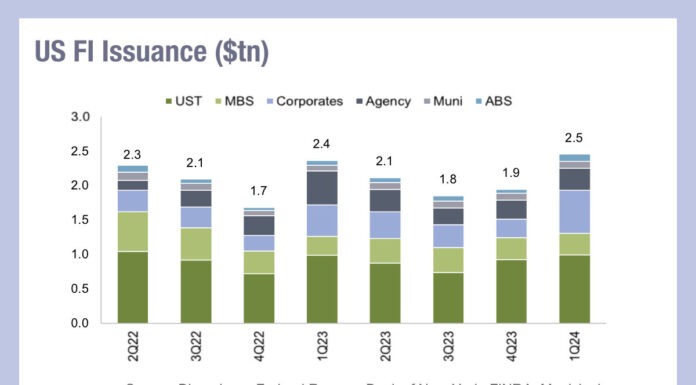Jon George and Alex Hardouin of Refinitiv discuss how they are mitigating relationship risk following the firm’s merger with LSEG.
How does the range of services available to your clients help them address trading challenges today?
 Jon George (JG): When I look at the inventory of capabilities that LSEG has following the Refinitiv deal, they are off-the-charts. If you run through the vertical services and products, pre-trade, at-trade, and post-trade our collective service offering is substantial. We have around 11,000 network partners on top of the traditional user base. We are reaching out to clients and demonstrating that Refinitiv goes well beyond the desktop; we run mark to market on portfolios with Refinitiv Evaluated Pricing Service, we have a global FIX API network and execution/order management system capabilities; our breadth of services is enormous.
Jon George (JG): When I look at the inventory of capabilities that LSEG has following the Refinitiv deal, they are off-the-charts. If you run through the vertical services and products, pre-trade, at-trade, and post-trade our collective service offering is substantial. We have around 11,000 network partners on top of the traditional user base. We are reaching out to clients and demonstrating that Refinitiv goes well beyond the desktop; we run mark to market on portfolios with Refinitiv Evaluated Pricing Service, we have a global FIX API network and execution/order management system capabilities; our breadth of services is enormous.
If you speak to any asset manager, they are trying to reduce complexity of the trading desk. There is also a drive for traditional asset managers to deliver truly multi-asset execution and it’s putting pressure on their EOMS infrastructure. We see a bifurcation between the larger houses that are running big supermarkets, doing everything at scale and with substantial technology investments. They are looking to us for our network. Then there is also this pool of boutiques managing smaller pools of capital, in less liquid assets, and they are keen to leverage our network and partnership capabilities. They have specialisations which they can maintain and develop on their own, but integrate within our partnership ecosystem, get data and technical support, sales alignment, and joint marketing. So, the client wins and the partner wins on the other side.
So you see an opportunity to cement new relationships with buy-side firms?
JG: Yes. If you look at the fixed income conundrum; liquidity, pre-trade transparency and TCA, the whole market was built on bilateral relationships and it has bilateral solutions off the back of that. If you look at pre-trade analytics, price makers and venues see value towards mediated services around delivering pre-trade insight, enhancing MiFID II and TRACE transparency.
This is a competitive field, what will trigger those discussions?
JG: We are an organisation that people feel very comfortable talking to. We have a broad portfolio that we are looking to leverage and join up. For example, our FIX network is huge and this connectivity is helping market participants communicate and interact across asset classes.
 Alex Hardouin (AH): There is I think a perception that Refinitiv was a stronger player in FX and equities than in fixed income, despite some unique content sets and capabilities. These have been enhanced with LSEG. For fixed income users we have great solutions, products, data and services like IFR, LPC loan content, FTSE Russell indices, convertible indices, and analytics all built and delivered via a single platform through acquisition and underpinned by the same underlying data.
Alex Hardouin (AH): There is I think a perception that Refinitiv was a stronger player in FX and equities than in fixed income, despite some unique content sets and capabilities. These have been enhanced with LSEG. For fixed income users we have great solutions, products, data and services like IFR, LPC loan content, FTSE Russell indices, convertible indices, and analytics all built and delivered via a single platform through acquisition and underpinned by the same underlying data.
Why might heads of trading on buy-side firms be looking for a partnership which can offer those solutions?
JG: If you look at, say, our leading FX franchise we have significant DNA in developed and importantly, emerging and frontier markets. Emerging and frontier market heads of trading have arguably been underserved by the industry as services have focused on developed and international bond markets. So, when we speak to buy and sell-side clients, some of them using quite rudimentary software, we can build and provide them with solutions leveraging our franchise and local market knowledge. We also offer a range of technology solutions to more than 150 central banks, helping them to operate the financial ecosystem, from primary and secondary markets through to post-trade, surveillance, data and analytics. If a client needs a simple order monitoring system for their middle to back office we also work with partners that can provide that so you can plug and play with confidence.
We are not forcing firms to buy an entire package; we give them the option to have a suite of capabilities to match their needs. When we introduce a partner, we run through all the due diligence. That client has to have real innovation DNA, it’s got to be seamlessly integrated with us from a business perspective, end-to-end workflow. We also know the partner will have operational alignment, data and technical support, sales alignment and joint marketing. That is the conversation we are having with many smaller boutique investors, who are crying out for workflow solutions.
In effect reducing their workload in onboarding?
JG: We are an aggregator of relationships. Finding out that we offer all these capability sets is quite something, with clients leveraging our community capabilities. For example, trading workflows can be very different so having the ability to customise services and tools is essential. Doing that without multiplying providers is fundamental to supporting evolution and efficiency. For our clients, just as traders focus their dealer lists, focusing on suppliers who can support every stage of the trading workflow will deliver a better return on the relationship.
How are you using those partnerships in fixed income?
AH: They support many content sets. We can deliver yield curves on the back of content from firms like Tradeweb, or interest rate swap content from interdealer brokers (IDBs). They are consumed either directly through analytics apps on the desktop, or via other feeds, APIs, and they are very popular because the constituents coming from those partners are very accurate. We also have composite and evaluated prices which are currently being used in middle and back offices for comparison or reconciliation prices on the most liquid govies and credit.
JG: Our content is supported by multiple global and domestic venues such as IDBs, MarketAxess, Tradeweb, CanDeal, CFETS and Yieldbroker. For CDS we have IHS Markit, for derivatives we have all the big brokers. Depending on the instrument and the asset class, then we have different providers.
Do you see that breadth as a strength?
JG: It is – composite prices are very popular, supporting pricing on illiquid instruments which can either be provided via desktop or feeds. If you look at the start of the pandemic in March last year, as price moves in risk-assets magnified, the need for our clients to rapidly reposition risk increased. All execution protocols across electronic and voice trading were utilised and the need to secure frequent and reliable price transparency, particularly in less liquid instruments, became even more crucial to gauge liquidity pricing. So, I think having a broad portfolio of price contributors is invaluable to better price discovery, liquidity discovery and execution.
©Markets Media Europe 2021





















